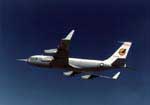Students plan a spin on NASA’s "vomit comet"
Posted by news
In hopes of finding ways to improve construction in space, eight University of Missouri-Rolla students will conduct reduced-gravity experiments on welding properties April 23 through May 3 aboard NASA’s KC-135 aircraft, the "vomit comet" that doubled as a command module for Tom Hanks and other cast members during the filming of the movie Apollo 13.
 |
| Grab a barf bag and take a seat. UMR students are planning to conduct near-zero-gravity experiments aboard NASA’s KC-135, known informally as the "vomit comet." (Photo courtesy of NASA.) |
"We submitted a proposal to NASA’s Reduced Gravity Student Flight Opportunities Program (RGSFOP)," says Kathy Gallagher, team member. "This is a competition that allows undergraduate teams to design and construct an experiment to be conducted in microgravity. From the submitted proposals, NASA chose UMR as one of 72 teams to fly their experiments."
The students are under the direction of Dr. Hank Pernicka, associate professor of mechanical and aerospace engineering and engineering mechanics, and Dr. Hai-Lung Tsai, professor of mechanical and aerospace engineering and engineering mechanics.
Pernicka, Tsai and their students want to study and understand how welding in near-weightlessness compares to welding on Earth. Prior to the KC-135 flights, the students will weld aluminum on the ground, in "normal" gravitational conditions.
The KC-135, known unofficially as the "vomit comet," flies in parabolic patterns to create a temporary environment of near weightlessness. As passengers on the plane, the UMR students will be accelerated quickly from about 24,000 feet to roughly 32,000 feet, and then back down in an arc. The plane generates enough inertia to create about 25 seconds of micro-gravity during each parabolic repetition. Director Ron Howard used the KC-135 in this way to create a near-weightless spacecraft setting in Apollo 13.
The students’ primary mission aboard the KC-135 will be to use Metal Inert Gas (MIG) or Gas Metal Arc Welding (GMAW), "which is the most popular and important welding method, to weld aluminum and study its behavior," says Tsai. Ultimately, they hope to find benefits to welding in space that will improve the speed of space construction.
"Any advance in making construction in space easier is beneficial. If a means by which welding can be done easily and reliably can be developed, it would be very useful to future construction in space," says Pernicka.